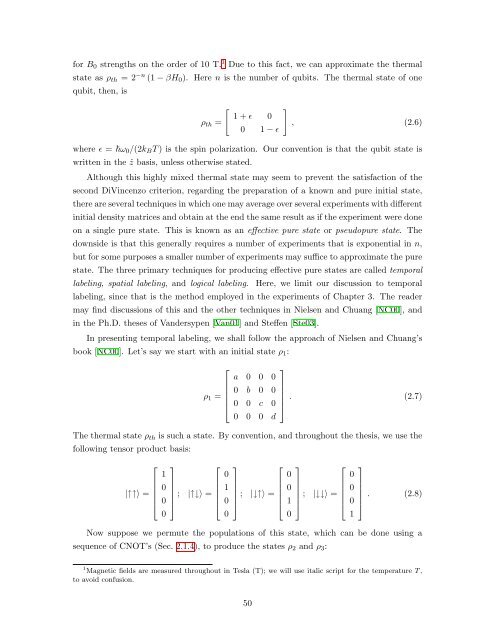Ph.D. Thesis - Physics
Ph.D. Thesis - Physics
Ph.D. Thesis - Physics
You also want an ePaper? Increase the reach of your titles
YUMPU automatically turns print PDFs into web optimized ePapers that Google loves.
for B0 strengths on the order of 10 T. 1 Due to this fact, we can approximate the thermal<br />
state as ρth = 2 −n (1 − βH0). Here n is the number of qubits. The thermal state of one<br />
qubit, then, is<br />
ρth =<br />
<br />
1 + ǫ 0<br />
0 1 − ǫ<br />
<br />
, (2.6)<br />
where ǫ = ω0/(2kBT) is the spin polarization. Our convention is that the qubit state is<br />
written in the ˆz basis, unless otherwise stated.<br />
Although this highly mixed thermal state may seem to prevent the satisfaction of the<br />
second DiVincenzo criterion, regarding the preparation of a known and pure initial state,<br />
there are several techniques in which one may average over several experiments with different<br />
initial density matrices and obtain at the end the same result as if the experiment were done<br />
on a single pure state. This is known as an effective pure state or pseudopure state. The<br />
downside is that this generally requires a number of experiments that is exponential in n,<br />
but for some purposes a smaller number of experiments may suffice to approximate the pure<br />
state. The three primary techniques for producing effective pure states are called temporal<br />
labeling, spatial labeling, and logical labeling. Here, we limit our discussion to temporal<br />
labeling, since that is the method employed in the experiments of Chapter 3. The reader<br />
may find discussions of this and the other techniques in Nielsen and Chuang [NC00], and<br />
in the <strong>Ph</strong>.D. theses of Vandersypen [Van01] and Steffen [Ste03].<br />
In presenting temporal labeling, we shall follow the approach of Nielsen and Chuang’s<br />
book [NC00]. Let’s say we start with an initial state ρ1:<br />
⎡ ⎤<br />
a 0 0 0<br />
⎢ ⎥<br />
⎢<br />
ρ1 = ⎢<br />
0 b 0 0 ⎥<br />
⎢<br />
⎣ 0 0 c 0<br />
⎥ . (2.7)<br />
⎦<br />
0 0 0 d<br />
The thermal state ρth is such a state. By convention, and throughout the thesis, we use the<br />
following tensor product basis:<br />
⎡ ⎤ ⎡ ⎤ ⎡ ⎤ ⎡ ⎤<br />
1 0 0 0<br />
⎢ ⎥ ⎢ ⎥ ⎢ ⎥ ⎢ ⎥<br />
⎢<br />
|↑↑〉 = ⎢<br />
0 ⎥ ⎢<br />
⎥<br />
⎢<br />
⎣ 0<br />
⎥;<br />
|↑↓〉 = ⎢<br />
1 ⎥ ⎢<br />
⎥<br />
⎢<br />
⎦ ⎣ 0<br />
⎥;<br />
|↓↑〉 = ⎢<br />
0 ⎥ ⎢<br />
⎥<br />
⎢<br />
⎦ ⎣ 1<br />
⎥;<br />
|↓↓〉 = ⎢<br />
0 ⎥<br />
⎢<br />
⎦ ⎣ 0<br />
⎥ .<br />
⎦<br />
(2.8)<br />
0 0 0 1<br />
Now suppose we permute the populations of this state, which can be done using a<br />
sequence of CNOT’s (Sec. 2.1.4), to produce the states ρ2 and ρ3:<br />
1 Magnetic fields are measured throughout in Tesla (T); we will use italic script for the temperature T,<br />
to avoid confusion.<br />
50
















